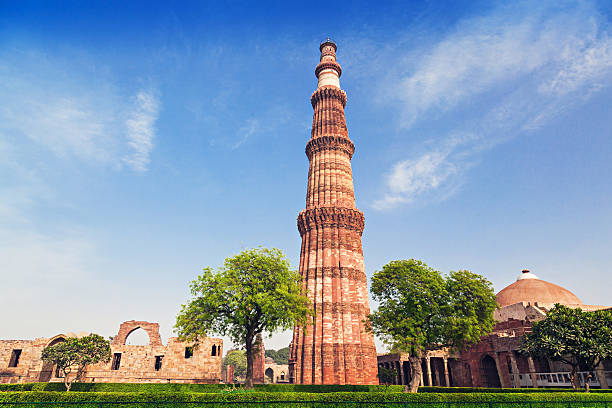Qutub Minar Tour

The Qutub Minar, an awe-inspiring symbol of Delhi’s rich history, stands as a testament to the architectural brilliance of ancient India. As one of the tallest minarets in the world, this UNESCO World Heritage Site draws visitors from around the globe, eager to explore its historical significance and breathtaking beauty. Here’s everything you need to know about taking a tour of the Qutub Minar.
A Glimpse into History

The Qutub Minar was commissioned by Qutb-ud-din Aibak in 1192, marking the beginning of the Delhi Sultanate. Its construction was continued by his successors, including Iltutmish and Firoz Shah Tughlaq, each adding their own contributions to this magnificent structure. Standing at 73 meters (240 feet) tall, the Qutub Minar is a marvel of Indo-Islamic architecture, with its intricate carvings and inscriptions that tell stories of the past.
The minar is surrounded by a complex of ancient structures, including the Quwwat-ul-Islam Mosque, the first mosque built in India, and the iconic Iron Pillar, which has baffled scientists for centuries due to its resistance to rust despite being over 1,600 years old.
Tour Highlights
-
The Qutub Minar The star of the complex, the Qutub Minar, is a stunning five-story tower made of red sandstone and marble. Each level of the minaret is adorned with intricate carvings and verses from the Quran. As you walk around the base, you’ll notice the distinct tapering design, with the diameter decreasing from 14.3 meters at the base to 2.7 meters at the top. Unfortunately, climbing the minaret is no longer permitted due to safety concerns, but the view from below is just as mesmerizing.
-
Quwwat-ul-Islam Mosque Adjacent to the Qutub Minar, the Quwwat-ul-Islam Mosque is a fascinating blend of Islamic and Hindu architectural styles. Built using materials from 27 dismantled Hindu and Jain temples, the mosque showcases a unique fusion of cultural influences. The intricately carved pillars and arches provide a glimpse into the artistic achievements of the period.
-
The Iron Pillar One of the most intriguing aspects of the Qutub Complex is the Iron Pillar, standing 7 meters tall and weighing over 6 tons. This ancient pillar, believed to have been erected by Chandragupta II, has stood the test of time and the elements, showing little to no signs of rust. The pillar is often associated with good luck, with a popular legend stating that if you can encircle it with your arms while standing with your back to it, your wish will come true.
-
Alai Darwaza As you continue your tour, don’t miss the Alai Darwaza, the grand gateway built by Alauddin Khalji in 1311. This beautiful structure, with its intricate latticework and arched openings, is a fine example of Indo-Islamic architecture. It serves as the entrance to the mosque and offers a glimpse into the grandeur of the Sultanate period.
Read More
Practical Information for Visitors
-
Location: The Qutub Minar is located in the Mehrauli area of Delhi, easily accessible by metro, car, or rickshaw. The nearest metro station is Qutub Minar Station on the Yellow Line.
-
Opening Hours: The complex is open daily from sunrise to sunset. Early morning visits are recommended to avoid the crowds and to experience the monument in the soft morning light.
-
Entry Fees: There is an entry fee for both Indian and international visitors, with discounts available for students and groups. Tickets can be purchased on-site or online for convenience.
-
Guided Tours: Hiring a local guide or joining a guided tour is a great way to enrich your experience, as they can provide detailed insights into the history and significance of each structure within the complex.
-
Photography: Photography is allowed, and the Qutub Minar offers numerous opportunities for stunning shots, especially during the golden hour. However, drone photography is not permitted.
Tips for a Memorable Visit
-
Visit Early: To avoid large crowds, especially during peak tourist season, aim to arrive early in the morning.
-
Dress Comfortably: Wear comfortable shoes and light clothing, as you’ll be doing a fair amount of walking.
-
Stay Hydrated: Bring water with you, especially during the warmer months, as Delhi’s climate can be quite hot and humid.
-
Respect the Site: The Qutub Minar is a protected historical site, so it’s important to follow all rules and regulations, including not touching or defacing the monuments.
Read More
Most Beautiful Places in Dubai
- Art
- Causes
- Crafts
- Dance
- Drinks
- Film
- Fitness
- Food
- Games
- Gardening
- Health
- Home
- Literature
- Music
- Networking
- Other
- Party
- Religion
- Shopping
- Sports
- Theater
- Wellness


